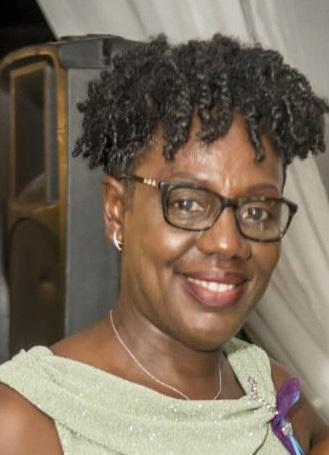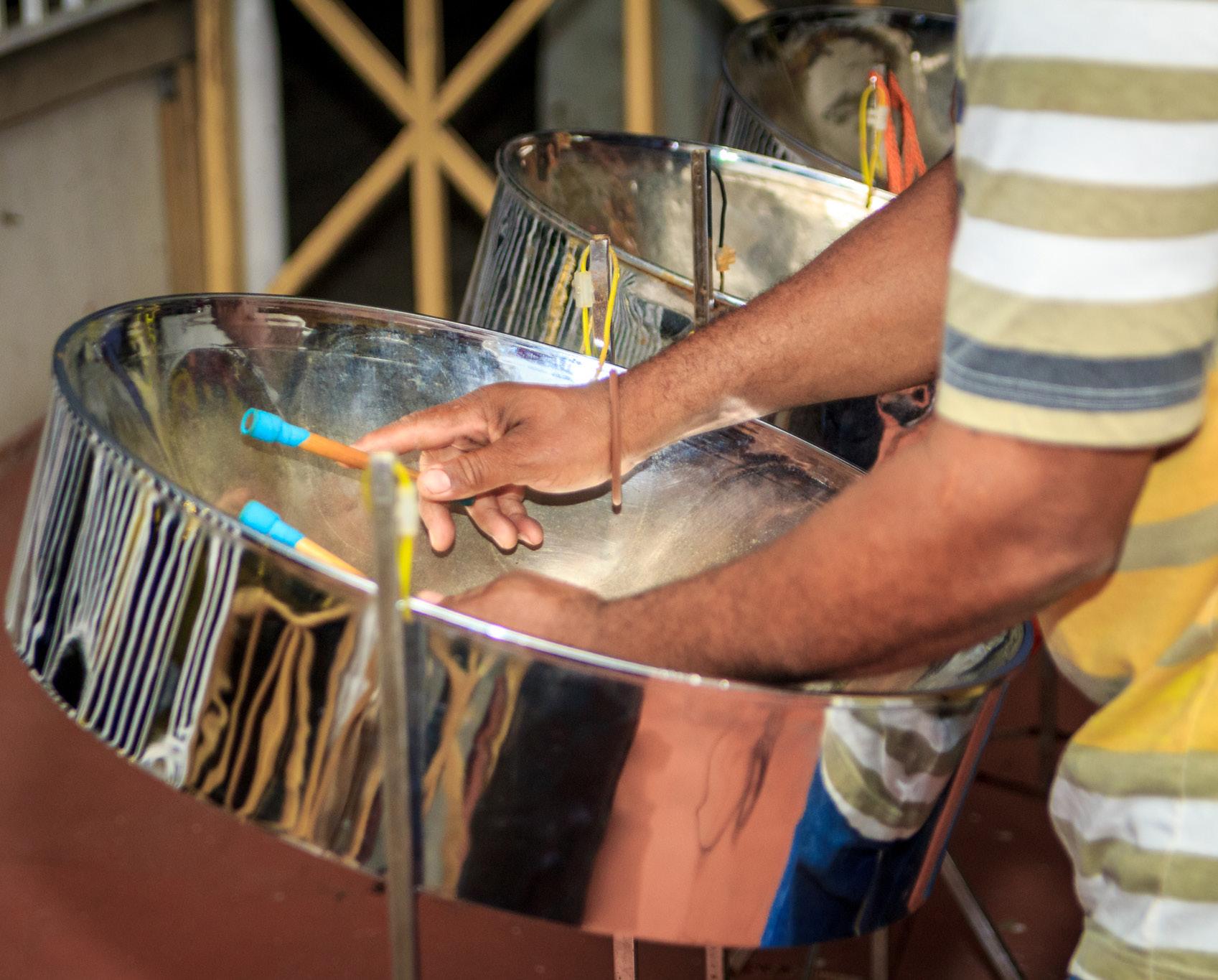
10 minute read
Steel Pan in Dominica
by Jacquline Andre
It would be remiss to write about Steel Pan in Dominica without mention of its unique and unbidden history. Steel Pan was not created under glamourous circumstances. It was not always regarded as fit to play in orchestra halls or churches. However, it is its very history that reminds West Indian people that innovation can spark from austerity. The Steel Pan is an instrument, though late in its contribution to the world of music, arguably tells one of its most important stories.
Advertisement
Steel pan began in Trinidad and Tobago in the 1930’s. This was a very different Trinidad and Tobago from the present. Before the costume bands and Machel Montano, Trinidad was severely affected by the worldwide depression of the 30’s. As workers were laid off from plantations, and wages on sugar estates and oil fields were lowered; living standards plummeted. There were strikes and riots which enticed racial unity among black workers. Under systematic British oppression, workers were treated unjustly to keep labor costs low. British colonists had banned African drums and Tamboo Bamboo on all estates. Therefore, the resilient spirits of black heritage prevailed as they did countless times in history before and Trinidad found art in their suffering. In the ghettos of Port of Spain, the Steel Drum was born. Music was made from the empty oil drums of an impoverished colony, that fueled Britain with up to 40% of its oil.
Shortly after, this musical revelation spread among the Caribbean islands. It was not until the late 1940’s and early 1950’s that Steel Pan came to Dominica. Bands like Brute Force, from Antigua travelled the island and played on the waterfront, now the Bayfront. The influence of Antiguan pan players sparked an interest in Dominica. Regrettably, the exact history of pan in Dominica was not carefully documented; however, from investigations the first set of Steel Pan bands were the Invaders and Merrymakers. These bands emerged from the capitol’s riverbank area. In 1953 Sun Valley Steelband was created, founded by a young Edward Andre with the assistance of Antiguan player Walty. It was the same Edward Andre who was later accredited by Dominicans to be one of the gatekeepers of Steel Pan music in the years to come. Other early Steel Pan activity in Dominica included the South Stars from Point Michel in the 1960’s. Moreover, the Vauxhall Steel Band with players like Athie Martin, Collin Bully, Fitzroy Williams, Curtis Henry and Derick Hyson. D-Special came around in the early 1970’s and was built by Eddie André and sponsored by Belfast Estate. The original players of D-Special were Abbu Elwin, John Simon, Thomas Baptiste, and Billy Doctrove. There were also the rivals of D-Special, called Chocolate County led by Errol Emmanuel and Fanta pan Demonium which started with the three daughters of Eddie André and the children in the neighborhood of Canefield. At the time D-Special was housed at the home of Eddie Andre, and his children would admire the band’s practice sessions and mimic the songs until Eddie built them pans of their own and started his own band, Fanta Pan Demonium. In 1976 the band was sponsored by Josephine Gabriel and Co. Fanta Pan was an iconic player in the Steel Pan scene in Dominica, as they would go on to be popularly known as the longest serving band on the island.
In the early years, these bands would go out serenading on the streets before Christmas. At this time there were no stands and Steel Pans were carried around the neck. There was a great sense of pride for the instrument in its conception in Dominica. Competitions were held among the bands on island. The bands also travelled regionally and took home titles in leading Steel Band countries like Antigua. Steel Pan became more incorporated in Dominica’s culture and at one time was an integral part of carnival celebrations. Steel Bands provided live music on the streets of Roseau during the carnival ‘jump up’. It is absolutely fitting that an instrument born from the oppression and deprivation of black people in ghettos, should be used in a celebration of emancipation of slavery. Many locals would argue that at that time ‘carnival was pan, and pan was carnival’.
In the 1980’s under the leadership of Wilfred Pancho Jno. Baptiste, Dominica saw the formation of a new kind of Pan Orchestra, a PanElect band called Phase 5. It was the fusion of Steel Drums with the electric guitar used for the bass. Athie Martin also contributed to the efforts of a more electronic sound, as he experimented with adding keyboards to accompany the pan. It meant that pan performances in Dominica could be condensed, and easy to transport. Innovative and convenient, the PanElect could be set up on smaller stages, or in lobbies of hotels.
As innovations in the Pan community were embraced, so did innovations in carnival. The live Pan Steel Orchestras were quickly replaced with large Hi 5 stereo systems. The music therefore by its nature, developed to a more electronic sound. Calypsos were able to be recorded and played on these stereo systems and did not necessarily need a steel pan rendition to be heard in the streets. Consequently, there was a decline in Steel Pan Orchestras in carnival parades, as they could not compete with the high volume, amplifying of electronic music.
Culture is not only important because it provides unity in a country’s values, beliefs, and interests; but participating in culture in itself, celebrates the defeat of past tribulations. Like the creole/patois language of Dominica, Steel Pan was born out of a need to communicate the song of the underdog. Its importance is invaluable and integral to Dominica’s people and how they relate to the world around them. In light of a global atmosphere, where black excellence is being sought out and celebrated, the dying interest of Steel Pan should not be taken lightly. Hope was not all lost. In the Early 2000’s, Dominica saw a spike in the number of young people interested in pan. During that time Pan by the Bay was organized by the Cultural Division and the Pan Association brought many groups to the Bayfront. Bands like Brizee’s Cultural Drama Club, directed by Anna Raffoul, Cool Steel, under the efforts of Wilfred Pancho Jno Baptiste, Genesis, RIC Jamming Steel, NBD Possie Culture Pan, Marigot Youth Steel, Marigot Senior Steel all performed for Carnival and
Independence activities. In fact, there was great promise for pan when on April 30, 2006 the first OECS Junior Steelpan Competition was held at the Botanic Gardens in Roseau, Dominica. The event was organized by then President of the Pan Association, Anna Raffoul. Bands participated from St. Vincent, Montserrat, Antigua, and Grenada. The Competition was won by the Antigua band and Dominica took the second place. This event brought about a strong interest in the steelpan movement. Brizee’s Pan Cultural Drama Club, a group of pre-teens and teens, were particularly enthusiastic and participated and placed in the 5 aside competition in Antigua. The group included, Jahsaywah Harve, Gabriella Shillingford, Deigton Voliere, Aminah Hausermann and Denzel Doctrove and gave an impressionable performance that wowed Antiguans and young potential Dominican players.
Following this there were immense efforts to bring pan to schools and drive youth interest in communities. Pan was brought to even more rural communities and created bands like St. Marks Steel Band, Mahaut Primary School, Community Band, Goodwill Secondary School, Dominica Grammar, Saint Mary’s Academy, St. Joseph, Viellecase, and Grandfond Community Band. One of the major highlights included the opening of the 30th Anniversary of Dominican Independence in 2008, when a mass youth steel band with members from the various bands around the island, performed the song “Dominica,” arranged for steel pan by Cornel Phillip.
It seemed however, that as the once excited youth came of age and started focusing on their adult lives, there was another decline in interest. As the pan instructors got older, and some deceased, there was also less leadership in the Pan community, and a lot of the bands became inactive. In May of 2014 however, Pan in Harmony was formed when the daughter of the late Eddie Andre, Jacqueline Andre, organized a tribute concert with a group of young talented steel pan players from Brizees Pan, Genesis and NBD Possie Culture. Since Genesis band was inactive at that time, the band stayed together. In May of 2019, the band was invited to perform at the Gwadadli Festival, a Musical, Culinary and Visual Art Festival held in Guadeloupe. Some group members still travel to other Caribbean islands like St. Lucia, and Antigua and participate in their national Pan Competitions. The group passionately believes that steel pan music in not only a carnival feature but should be enjoyed throughout the year. Pan in Harmony has been providing music for various functions and hosts annual concerts to date. Recently Pan in Harmony participated in an international vertical pan event which

Though this proves a subtle continuation of the pan movement, in a broader perspective, Dominica lacks the same hunger for Steel Pan survival that it did when it first started. There are many hurdles. First, there were only ever two pan tuners on the island; Miguel Dublin and Eddie André. In the early 1980’s Miguel fell ill and was unable to continue tuning; and in 2014 Eddie Andre also fell ill and succumbed to his illness. There were also very few tutors on the island. The bands depended on Wilfred Pancho Jno. Baptiste and Eddie Andre to train the young players. Pancho fell ill shortly before Eddie Andre and recently passed. The island is now left without a tuner and tutors, and the already diminishing interest of the youth. Lastly, as one of the many unfortunate effects of hurricane Maria in 2017, many bands lost their pan yards and are left with nowhere to practice.
There are a few glimmers of hope for the art form after all. Presently there are some young tutors like Pious John Baptiste, Chad Zamore, Vernandra Christian, Deigton Voliere who are training young ones on the steel pan. Also, in January of 2019 a Steel Pan Development Project was initiated when Alwin Bully, with the support of Mr. Ian Munroe, Chairman of the Dominica National Lotteries Commission. The mission was to enhance Carnival 2019 via the revival of Steelpan music. A small committee was created to manage the project, and two phases were outlined. Members of the committee were Alwin and Anita Bully – Cultural Administrators, Collin Bully – Former Pannist, Raymond Lawrence - Division of Culture, NCC and DIFA, Wayne Alonzo - pannist, Urban Martin – musician, and Jacqueline Andre - Director of Pan in Harmony. Phase 1 would bring back the Steel Pan as a part of our carnival product and sensitize the public to its value. Phase Two is to rekindle the interest of steel band playing in schools and identify and train people who may be interested in the tuning of pans or musical compositions. Unfortunately, this phase was interrupted by the Global pandemic of Covid-19 in 2020.
Undoubtedly, the inception of pan did not necessarily emerge from ideal circumstances. After all, there are few notable events in history that were birthed from utopia. The Steel Drums however, is an intricate part of West Indian culture; one that reminds us of our strength. Dominicans, as part of the Caribbean community, must continue to carry the musical baton. We must keep the same resilient spirit that made us bond together in language during slavery and in sound in the suffering of the 1930’s. As Dominica faces a global pandemic, climate change, and all other new age adversities, we must remember the things that once paved the way for our survival. We are here, and united because of our ancestors’ love for music and the Steel Drums.











